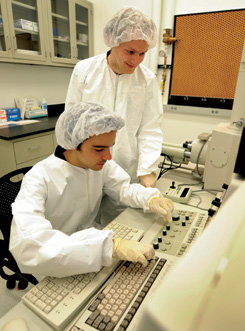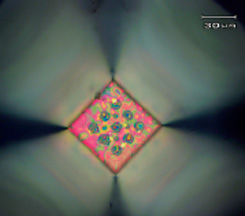Eye on the Quads
It's A Small World
Physics students Laszlo Frazer and Adam Weis run big experiments on a tiny scale.
“Tweezer skills are a very important part of the job, and very underrated,” reflects Adam Weis, AB’08. He’s not talking about forensics or beauty school, but about the work he shared with fourthyear Laszlo Frazer as a research assistant in physics professor Heinrich Jaeger’s lab last summer. As part of their work, Weis and Frazer handled and prodded super-strong nanoparticle “sheets” as tiny as a few thousand atoms.
The sheets are as tough as common building materials and may have practical applications beyond the laboratory. “We speculate that they could be used as pressure sensors integrated into electronics,” Frazer says. Jaeger adds that they may be used in new types of nanosensors and nanosieves. Frazer and Weis needed patience and above-average hand-eye coordination to carry out their daily work. “One sample could take days to prepare, and then you accidentally flip a microchip upside down, and it breaks,” Weis says.
The nanoparticle sheets–which are the width of a human hair– spontaneously form when liquid mixed with gold or cobalt particles evaporates off a silicon microchip. Weis describes the microchip as a “table with holes on it” that the sheets stretch across, like a tablecloth. Jaeger calls the sheets “the world’s smallest trampolines.” He says, “What is special about Weis’s and Frazer’s project is that they showed how these sheets can be suspended freely, without any underlying support, over distances of many thousand particles.”
The two were able to measure the strength of each sheet using an atomic force microscope. “Just as a person can gauge the strength of a trampoline by jumping on it, we use the tiny needle of an atomic-force microscope to poke the sheet in order to measure its strength,” Jaeger explains. They found, Frazer says, “that gold arrays are stronger than most plastics. Cobalt we’re still analyzing, but we think it’s comparable to hardwood or concrete.” The research team also ran computer simulations that further assessed each sheet’s properties.
To work successfully in a faculty lab as an undergraduate requires an extraordinary analytical capacity and no small intellectual ambition. But “Chicago undergrads are quite special in their breadth of knowledge and their ability to tackle complex problems,” Jaeger says. “Adam and Laszlo have been working at the level of graduate students on this project. Both of them were able to get involved in cutting-edge research quickly.” Frazer and Weis were glad to find their network of scientific mentors expanded when they joined the lab.
Frazer, a swimmer and clarinetist who came to Chicago from rural North Carolina to study physics, made authentic research experience a priority. “[Physics] originally seemed cool, and now I get to do something new every day. It never gets boring with diverse problems to solve,” Frazer says. He transferred to Chicago last year specifically to work in a lab, which was not possible at his previous college. He hopes to pursue graduate studies in physics after graduating next spring.
Weis was not as excited about the discipline until “I read a book on time travel, as dorky as it may seem, and got into physics,” he says. Before joining Jaeger’s lab, he spent time “doing computer simulations of particles in fluid” in Santiago, Chile, as part of the Chicago-Chile Materials Collaboration exchange program between Chicago, the University of Chile, and the University of Santiago. He “decided I was not a big fan of computer simulations,” however, and returned to Chicago eager to take on experimental work.
Currently Weis, who grew up in Louisville, is studying for a physics PhD at the University of Illinois at Urbana-Champaign. He says his experience in Jaeger’s lab was a formative one. “Working in a lab is the most important thing I did here. I was surprised at how much it seems important to have a willingness to try things out. You could spend years trying to prepare for an experiment theoretically, but generally it works better to try it out.”
Jaeger notes that his research group will publish the results of their summer work in the near future, with Frazer and Weis as coauthors.—Christine Minerva, AB’02

